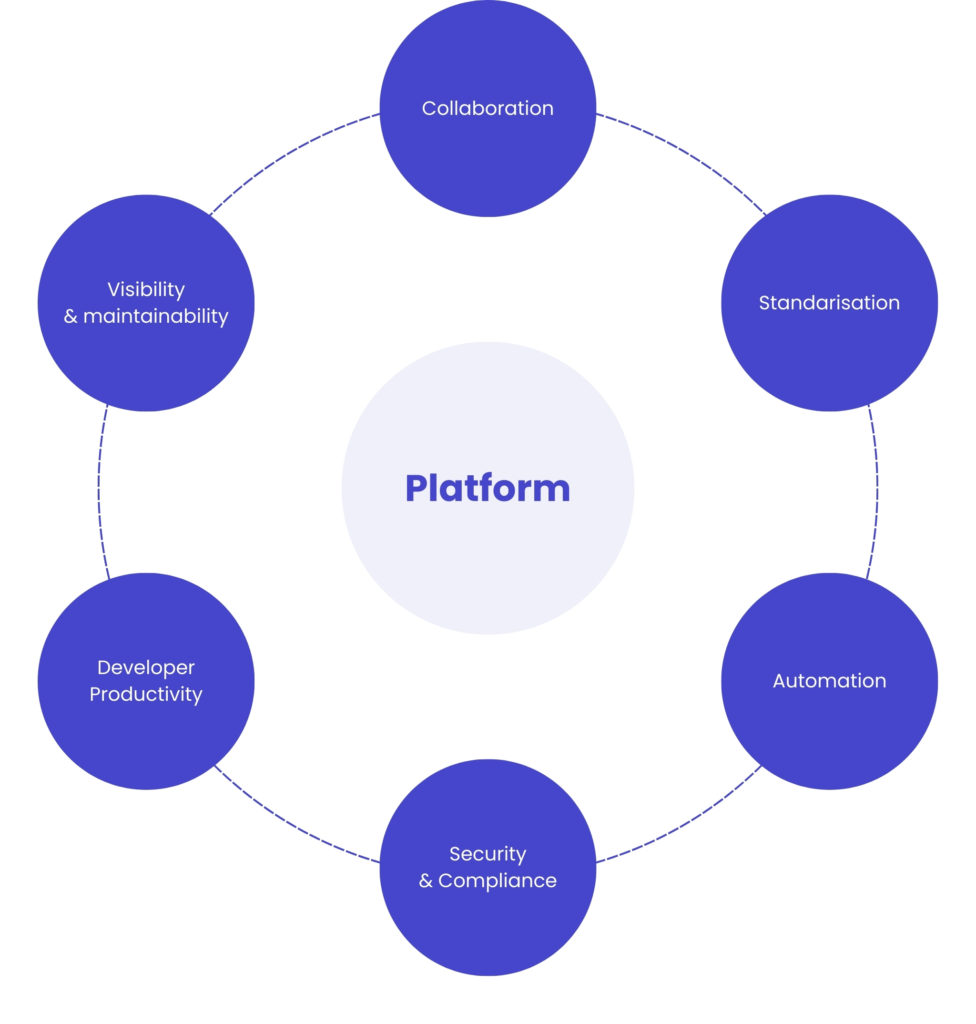How platform engineering can boost development teams’ productivity & cut costs
The adoption of cloud platforms such as AWS, Azure and Google Cloud has transformed the way businesses develop and expand their technology. While these platforms offer remarkable flexibility and capability, they also introduce a new level of complexity. In the early stages of cloud adoption, it was common for each product team to design its own approach to infrastructure, monitoring and deployment. With every team running its own strategy, often with a dedicated DevOps engineer – this worked well enough on a small scale.
However, as organisations grew, this fragmentation became a major challenge. Different infrastructure setups created silos and inconsistent monitoring practices made system-wide observability difficult, and cloud costs began to spiral without unified controls.
Although initial attempts to address these issues, they didn’t eliminate the root cause. Every team was still solving the same infrastructure problems in isolation. The result was frustration, and inefficiency. Platform engineering came about precisely to solve these issues. By creating a standardised abstraction layer over cloud infrastructure, platform teams can unify deployments, streamline monitoring, optimise costs and empower product teams to focus on delivering business value rather than managing infrastructure.
In this article, we explore the key differences between cloud and developer platforms, explore the common issues that arise when they aren’t used, and explain how platform engineering addresses these problems through standardisation, automation and self-service.
Cloud platforms vs. developer platforms
In the context of cloud computing, major platforms such as AWS, Azure and Google Cloud are often referred to as landing zones. These are foundational environments that enable organisations to organise, provision, and secure server resources in the cloud according to enterprise governance, compliance, and security policies. A landing zone generally includes pre-configured networking, security controls and policies, ensuring that applications and workloads can run safely and consistently in the cloud. Cloud platforms primarily focus on infrastructure management, scalability, and resource allocation.
However, while these landing zones are vital, they do not fully address the day-to-day challenges that developers face. In such cases, developer platforms, or internal developer platforms, can provide a solution. These represent a significant emerging trend, specifically designed to address common challenges faced by developers, including reducing cognitive load, automating repetitive tasks, and standardising development workflows. Developer platforms are tailored environments built on top of cloud platforms, providing developer-centric features such as self-service provisioning, reusable templates, CI/CD pipelines, and automation for compliance and observability. The result is a streamlined and efficient developer experience, designed to maximise productivity.
Boost developer productivity & cut cloud costs up to 30%
Find out morePut simply, while cloud platforms lay the foundations enterprise-level requirements, developer platforms pave the path for developer efficiency and velocity. Developer platforms offer the valuable benefit of abstraction and automation above the landing zone, enabling developers to focus on the core task of building and shipping applications. This is because they are no longer required to expend time and effort on infrastructure setup, access management or compliance processes. The combination of well-governed cloud landing zones and robust developer platforms is key to enabling development teams to deliver business value quickly, efficiently and securely.
What is platform engineering?
Platform engineering is the practice of developing and maintaining unified, developer-centric platforms that provide a stable foundation for software delivery. Unlike traditional approaches, in which teams work with fragmented tools and environments, platform engineering centralises workloads and creates a consistent, standardised ecosystem. This improves visibility and maintainability and makes it easier to manage costs and optimise resources.
At its core, platform engineering is about enhancing the developer experience. By embedding automation, security and compliance into the platform, engineering teams can accelerate delivery, reduce errors and enable faster, more reliable releases. Developers benefit from self-service capabilities, reusable templates and streamlined workflows that reduce cognitive load and free them up to focus on building features rather than dealing with infrastructure or repetitive setup tasks.
A well-designed platform also promotes collaboration and standardisation across teams, ensuring that everyone works with the same practices, tools and governance. This stability doesn’t limit innovation, instead, it encourages it. With a robust and secure foundation in place, businesses can experiment with, adapt to, and deploy new technologies more effectively, thus enabling rapid development without compromising reliability.

DevOps vs SRE vs Platform Engineering
DevOps, Site Reliability Engineering and Platform Engineering. Although these fields share common roots and goals, they address different layers of the software delivery lifecycle. It is essential to understand how they differ and complement one another in order to build scalable, reliable and cost-efficient systems.
- DevOps is a cultural and organisational approach that aims to eliminate the barriers between the development and operations teams. Its main objectives are to encourage collaboration, automate processes and deliver software more quickly and reliably. Rather than being a role or a single toolset, DevOps is a philosophy supported by practices such as continuous integration and delivery (CI/CD) and infrastructure as code.
- Site Reliability Engineering originated at Google and can be seen as a concrete implementation of DevOps principles, focusing strongly on reliability and operational excellence. SRE teams use software engineering methods to solve operational problems, ensuring that systems are scalable, robust and accessible. They use metrics such as service-level objectives (SLOs) and error budgets to strike a balance between innovation and reliability.
- Platform Engineering, by contrast, provides the structured foundation on which DevOps and SRE practices can prosper. Rather than each development team building its own pipelines and tooling, platform engineers create a shared internal developer platform (IDP). This standardises workflows, integrates automation and security, and provides self-service capabilities, thereby reducing the cognitive load on developers and ensuring operational consistency.

The challenges that platform engineering solves
Lack of standardisation
In many organisations, each development team sets up its own tools, pipelines and monitoring methods. While this offers flexibility, it quickly leads to fragmentation and inconsistent practices. These inconsistencies complicate debugging and incident response, and increase operational risks when scaling across teams or regions.
Resolution -> Platform engineering establishes a consistent layer of tooling, processes, and environments, eliminating duplicated efforts and ensuring teams adhere to well-defined best practices. The result is improved reliability, reduced cognitive load and faster onboarding for new engineers.
Rising costs
While the cloud offers flexibility, it also comes at a price. Without proper oversight, expenses can escalate due to underutilised resources, shadow IT or poorly optimised deployment strategies. Various industry studies have highlighted that cloud spending is now one of the fastest-growing areas of IT budgets.
Resolution -> A cloud-smart platform integrates cost monitoring, automated rightsizing and resource governance directly into the workflows of developers. This gives teams visibility of actual usage patterns, leading to more responsible consumption. Organisations that have adopted these practices have reported significant savings, with infrastructure spending often being reduced by up to 60% while maintaining performance.
Low developer productivity
Development teams often spend an excessive amount of time on tasks such as provisioning infrastructure, configuring CI/CD pipelines and troubleshooting cloud environments. This diverts their focus away from their core mission of delivering customer value. In highly competitive markets, this inefficiency results in a slower time-to-market.
Resolution -> By abstracting infrastructure management behind self-service capabilities and reusable components, developers can focus on building business-critical features instead of reinventing the wheel. Platform engineering provides teams with secure, ready-to-use environments, thereby improving delivery speed, job satisfaction and innovation capacity.
The core benefits of platform engineering
Enhanced developer productivity & experience
- Streamlined workflows and automation – Platform engineering removes infrastructure complexities, letting developers focus on building software rather than managing environments and configurations. This leads to higher velocity and job satisfaction.
- Self-service and standardisation – Developers can provision resources and deploy applications themselves, reducing bottlenecks and accelerating delivery cycles.
- Consistent development environments – Uniform development and deployment setups minimise errors and context-switching, enabling faster onboarding and more efficient collaboration
Business agility, scalability & cost efficiency
- Faster time-to-market – Automated CI/CD pipelines and standardised processes enable rapid feature and product launches, maintaining competitiveness.
- Scalability by design – Platforms enable seamless scaling of applications and services, adapting easily to business growth or changing demands.
- Cost optimisation – Resource usage and cloud expenses are managed and rightsized, reducing waste and improving operational efficiency. Typically, these costs are reduced by 15–30% in the initial stage of implementation.
Security, compliance & collaboration
- Built-in security and compliance – Centralised management ensures robust security controls, compliance checks, and governance by default, mitigating risks.
- Reliable operations – Automated monitoring, alerting, and rollback systems improve system uptime and resilience, strengthening customer trust.
- Enhanced cross-team collaboration – Breaking down silos, platforms provide shared tools and standardised processes that boost communication between development, DevOps, and business teams.
Wrapping up
The message is simple – the more time your development teams spend grappling with infrastructure issues, the less time they have to deliver value. Platform engineering solves this problem by providing teams with the right tools, standardised processes and automation to enable them to work smarter, faster and with greater cost control.
So, if you’re looking to boost developer productivity, manage cloud spending more effectively and establish a foundation for long-term success, it’s time to adopt platform engineering. Contact our specialists to find out how we can help you design and implement a bespoke platform for your business.
Cloud platforms such as AWS, Azure and Google Cloud provide the foundational infrastructure (landing zones) necessary for running applications in a governed, secure and scalable manner. By contrast, developer platforms are built on top of cloud platforms to reduce cognitive load for developers. They offer self-service provisioning, reusable templates, continuous integration/continuous delivery (CI/CD) pipelines, and automation. This allows developers to concentrate on developing applications rather than managing infrastructure.
As companies grow, inconsistent infrastructure and practices across teams can create silos and inefficiencies, as well as rising cloud costs. Platform engineering tackles these problems by providing a unified, standardised developer platform that automates infrastructure management, streamlines workflows, incorporates security and compliance measures, and optimises costs.
Platform engineering streamlines infrastructure processes by automating repetitive and manual tasks, providing developers with self-service capabilities and pre-configured environments. This reduces the time spent on context switching and setup, enabling developers to focus more on building and delivering business-critical features.
Lack of standardisation – eliminates fragmented tooling and processes.
Rising cloud costs – provides governance, cost monitoring, and automated resource optimisation.
Low productivity – abstracts infrastructure complexities, letting developers focus on innovation.
DevOps promotes collaboration between development and operations, while SRE applies engineering practices to ensure reliability. Platform engineering complements both by providing a shared internal developer platform (IDP) that standardises workflows, embeds automation and compliance, and enables DevOps and SRE to scale more effectively.
About the author
Contact us
Focus on your core business, while we manage your IT infrastructure maintenance
Recommended articles





